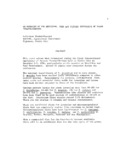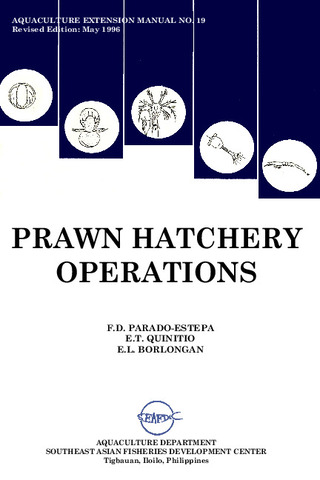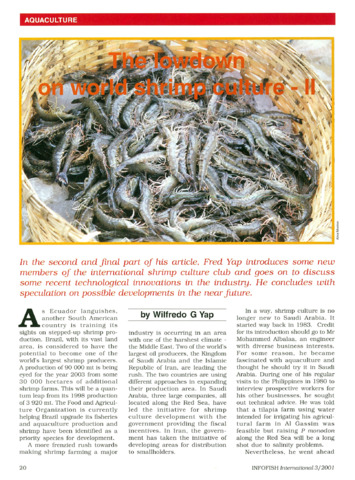Experimental evaluation of probiotics as biocontrol/bioremediation in the rearing of shrimp (Penaeus monodon)
- Global styles
- MLA
- Vancouver
- Elsevier - Harvard
- APA
- Help

View/
Preview (Limited to 10 pages)
deCastro-MallareTR2005.pdf (1.440Mb)
 AQD Access
AQD Access
 AQD Access
AQD Access
Downloads: 5
Date
2005-03Page views
1,611ASFA keyword
AGROVOC keyword
Taxonomic term
Metadata
Show full item record
Share
Abstract
Two hundred fifty-liter (250-L) fiberglass tanks each equipped with 15-L capacity filter tanks are adequate for screening of commercial probiotics. The application of some commercial probiotics in the culture water is more advantageous than adding it to the feeds. Probiotics A, C, and F, when added to the culture water, gave significantly different (P<0.05) average body weights (ABW) and survival rates (SR) of shrimp (Penaeus monodon) compared with other treatments. Probiotics B, D, E, and G when added to the culture water had higher ABWs but were not significantly different (P>0.05) from the other treatments. SR when Probiotic G was added was significantly different (P<0.05) from the control. The results of this study showed that one should be cautious in the use of commercial probiotics because not all are effective. Users should also take note of the active ingredients in the product they buy.
Suggested Citation
de Castro-Mallare, T. R., Golez, N. V., & Tendencia, E. A. (2005). Experimental evaluation of probiotics as biocontrol/bioremediation in the rearing of shrimp (Penaeus monodon). In K. Nagasawa (Ed.), Recent Advances in Diagnosis and Prevention of Fish and Shrimp Diseases in Southeast Asia (pp. 153–167). Tigbauan, Iloilo, Philippines: Aquaculture Department, Southeast Asian Fisheries Development Center.
Type
Book chapterISBN
9718511732
Related items
Showing items related by title, author, creator and subject.
-
An overview of the nutrition, feed and feeding techniques of prawn penaeid/shrimps
Piedad-Pascual, Felicitas (Philippine Council for Aquatic and Marine Research and Development, 1989)This paper echoes what transpired during the first International Conference of Penaeid Prawns/Shrimps held in Iloilo City in December 4-7, 1984, particularly on the Nutrition nd Feed Development. Around 25 papers were ... -
Series: Aquaculture extension manual; No. 19
Prawn hatchery operations
Parado-Estepa, Fe D.; Quinitio, Emilia T. ; Borlongan, Emeterio L. (Aquaculture Department, Southeast Asian Fisheries Development Center, 1996-05)
The manual, an updated version of the 1984 SEAFDEC/AQD manual, presents the underlying principles and step-by-step instructions of prawn larval and post-larval rearing. The techniques described are not only applicable to ...
; Borlongan, Emeterio L. (Aquaculture Department, Southeast Asian Fisheries Development Center, 1996-05)
The manual, an updated version of the 1984 SEAFDEC/AQD manual, presents the underlying principles and step-by-step instructions of prawn larval and post-larval rearing. The techniques described are not only applicable to ... -
The lowdown on world shrimp culture - II
Yap, Wilfredo G. (INFOFISH, 2001)This paper introduces some new members of the international shrimp culture club and goes on to discuss some recent technological innovations in the industry, particularly the polyculture of tilapia (mainly Oreochromis ...





